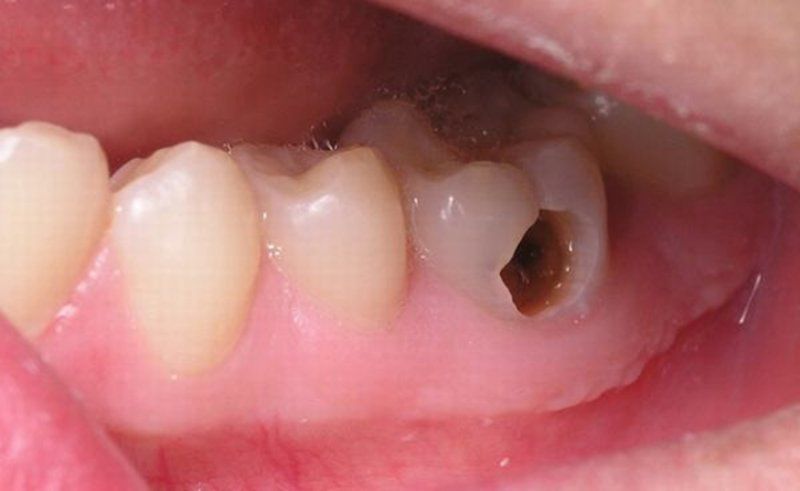Tooth decay reaching the pulp is a common and concerning dental issue. This condition not only causes significant pain but also poses risks to oral health. When tooth decay progresses to the pulp, it can impair tooth function and potentially lead to more serious health problems. In this article, we will explore the reasons behind tooth decay reaching the pulp.
1. Understanding Tooth Decay Reaching the Pulp
1.1 What is Tooth Decay Reaching the Pulp?
Tooth decay reaching the pulp occurs when bacteria causing tooth decay penetrate the enamel and enter the pulp, the innermost part of the tooth. The pulp contains blood vessels, nerves, and connective tissue. When bacteria invade the pulp, they can cause infection and severe pain.
Bacteria can infiltrate the pulp through small holes in the enamel. This usually happens when tooth decay is not treated promptly or when there is a small injury on the tooth’s surface.

Pulp-involved tooth decay originates from bacteria infiltrating the pulp through small cavities.
1.2 Process and Symptoms of Tooth Decay
Early Stage
In the initial stage, bacteria attack and destroy the enamel, creating a cavity. At first, the cavity may be small and cause no noticeable effects. However, if left untreated, bacteria can penetrate deeper into the pulp, enlarging the cavity and leading to more severe pain.
Advanced Stage
As decay progresses deeper into the pulp, it destroys the pulp tissue, weakening the internal structure of the tooth. Bacteria invade further, causing pulpitis (inflammation of the pulp). At this stage, symptoms like increased sensitivity to temperature and pressure, and pain during eating and drinking become evident.
Pulp Necrosis
If pulpitis is not treated, the pulp may die, causing the pain to cease. However, this indicates severe damage. The tooth may develop an abscess, characterized by swelling and pus formation. Over time, the decayed tooth can break, and white spots may appear at the gumline, indicating infection.

Pulp-involved tooth decay is a consequence of long-term untreated cavities.
2. Causes of Tooth Decay Reaching the Pulp
Several factors contribute to the development of tooth decay that reaches the pulp:
– Bacteria and Plaque: Oral bacteria, especially Streptococcus mutans, produce acids from food. These acids erode the protective enamel, leading to cavities.
– Unhealthy Diet: Consuming high amounts of sugar and starch creates an environment conducive to bacterial growth. Sugary drinks, sticky foods, and acidic beverages also contribute to tooth decay.
– Poor Oral Hygiene: Inadequate brushing and infrequent flossing fail to remove plaque and food particles, increasing the risk of cavities. Proper dental care is essential to prevent decay.
When cavities are neglected, they destroy tooth structure, reach the pulp, and cause infection.
3. Risks of Tooth Decay Reaching the Pulp
Untreated tooth decay can lead to several serious issues:
– Pain and Discomfort: This condition often results in significant pain, especially when consuming hot, cold, or sweet foods, and when chewing.
– Pulp Infection: Bacteria can infect the pulp, leading to inflammation and possible abscess formation, causing swelling and further complications.
– Nerve Damage: Decay reaching the pulp can damage nerves, causing extreme pain and potentially requiring surgical intervention.
– Tooth Loss: In severe cases, untreated decay can spread to surrounding teeth and bone, leading to tooth loss.
– Overall Health Impact: Severe dental infections can affect overall health, potentially causing conditions like arthritis, meningitis, septicemia, and cardiovascular problems.
4. Treatment for Tooth Decay Reaching the Pulp
4.1 Early Stage without Complications
If decay has not caused significant complications, a dentist will administer local anesthesia, remove the infected pulp, and seal the root canal to prevent further infection. The tooth can then be restored with a filling or crown.

Dentists prescribe treatment methods for cavities penetrating to the pulp based on each patient’s condition.
4.2 Advanced Infection
In cases of advanced infection, a minor surgical procedure may be necessary to remove the infected tissue. The dentist will clean the area, remove any infected bone, and fill the root canal, sealing it with a filling or crown.
4.3 Pulp Necrosis
If the pulp is necrotic, the dentist will extract the tooth to prevent the spread of infection. Once the area is healed, the tooth can be replaced with an appropriate dental prosthetic to restore chewing function.
Understanding the causes and treatments of tooth decay reaching the pulp helps in maintaining better oral health. By practicing good oral hygiene and seeking prompt dental care, the risks associated with this condition can be minimized.








